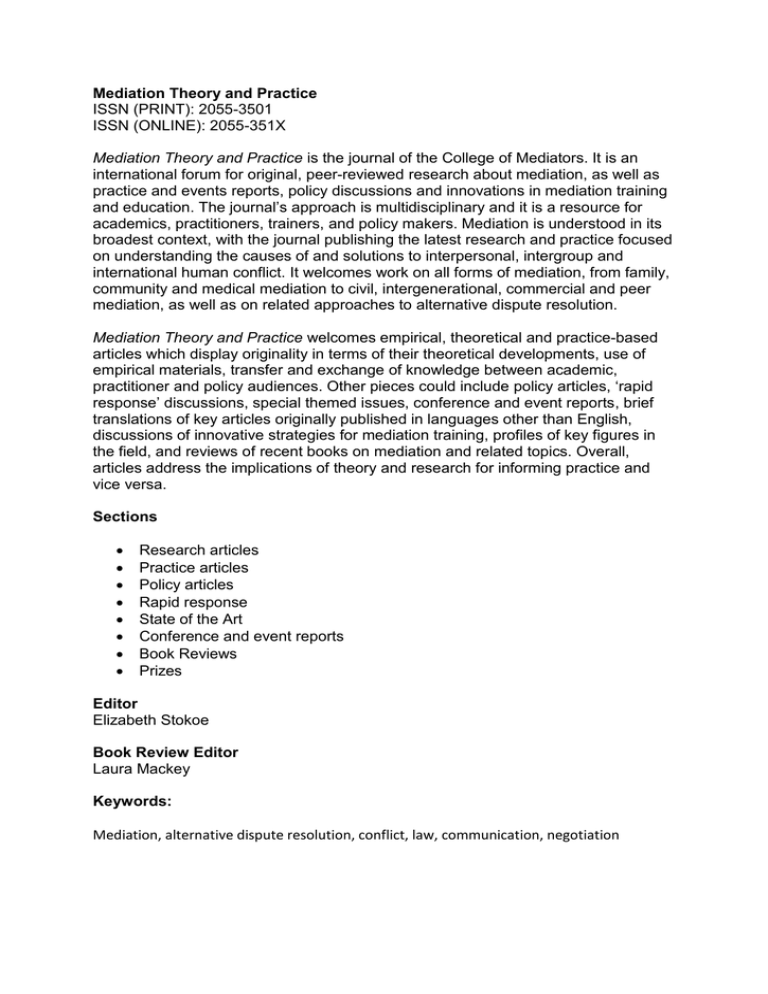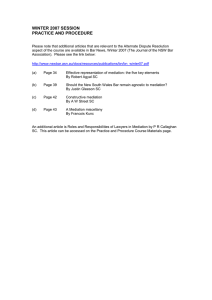Mediation Theory and Practice ISSN (PRINT): 2055
advertisement

Mediation Theory and Practice ISSN (PRINT): 2055-3501 ISSN (ONLINE): 2055-351X Mediation Theory and Practice is the journal of the College of Mediators. It is an international forum for original, peer-reviewed research about mediation, as well as practice and events reports, policy discussions and innovations in mediation training and education. The journal’s approach is multidisciplinary and it is a resource for academics, practitioners, trainers, and policy makers. Mediation is understood in its broadest context, with the journal publishing the latest research and practice focused on understanding the causes of and solutions to interpersonal, intergroup and international human conflict. It welcomes work on all forms of mediation, from family, community and medical mediation to civil, intergenerational, commercial and peer mediation, as well as on related approaches to alternative dispute resolution. Mediation Theory and Practice welcomes empirical, theoretical and practice-based articles which display originality in terms of their theoretical developments, use of empirical materials, transfer and exchange of knowledge between academic, practitioner and policy audiences. Other pieces could include policy articles, ‘rapid response’ discussions, special themed issues, conference and event reports, brief translations of key articles originally published in languages other than English, discussions of innovative strategies for mediation training, profiles of key figures in the field, and reviews of recent books on mediation and related topics. Overall, articles address the implications of theory and research for informing practice and vice versa. Sections Research articles Practice articles Policy articles Rapid response State of the Art Conference and event reports Book Reviews Prizes Editor Elizabeth Stokoe Book Review Editor Laura Mackey Keywords: Mediation, alternative dispute resolution, conflict, law, communication, negotiation Guidelines for Submissions Mediation Theory and Practice publishes articles that contribute to empirical, theoretical and practical understandings of mediation and related realms of practice. It is an interdisciplinary publication with a diverse audience including scholars and practitioners across such disciplines as law, communications, social policy, education, psychology, international relations, political science, organizational behaviour, anthropology, business and economics. The editor welcomes Research Articles (typically reporting the results of empirical research or theoretical pieces), Practice Articles (typically reporting both training teaching practice, contextualized in current debates, and including reflections on research but focused particularly towards concrete guidance for practice; these can include case studies), Policy Articles (as previously but with a particular focus on local, regional, national or international mediation policy). These articles will be peerreviewed. Rapid Responses (typically responding to live debates in mediation research, practice or policy with the aim of fast-tracked publication), Conference and Event Reports, Book Reviews, Review Essays, and articles that have been awarded MTP prizes, for publication in future issues of Mediation Theory and Practice will all be internally review. Please adhere to the guidelines below when preparing submissions for the journal. Initial submissions 1. Submission of articles to Mediation Theory and Practice should be done via the journal’s website at www.equinoxjournals.com. You will need to register with the website as an author, and follow the instructions and guidelines relating to submission. Authors who are unable to use this website for online submission should contact the editors for advice on how to submit their manuscripts. 2. Original Research Articles are to be submitted in English and have a word limit of 8,000 including endnotes and references. Appendices may be included, but are included in the total word count. Longer articles will be rejected automatically and the author/s asked to resubmit according to the guidelines. 3. Word limits for other submissions are as follows: Practice Articles (5000), Policy Articles (5000), Rapid Responses (2000), Conference and Event Reports (1000), Book Reviews (1000), Review Essays (5000), and Prize-winning articles (8000). 4. All articles (excluding Book Reviews) should have an abstract of no more than 200 words. This is important as it is what the online searching system is based on. The abstract must include the main points of the article. 5. Provide a list of up to six keywords. 6. Authors should ensure that all submissions, whether first or revised versions, are anonymised to facilitate blind reviewing. Authors’ names and institutional affiliations should appear only in the covering email message. 7. Please ensure that the details you supply include a contact address, including email. This information will not be sent to reviewers. 8. Proposals for special issues, accompanied by an overall rationale and abstracts of individual papers, should be sent by email to shussell@equinoxpub.com. 9. Submission of any article is taken to imply that it has not previously been published or is not being considered for publication elsewhere. If an author is publishing a related article elsewhere, this fact should be stated. In general, authors are asked to submit no more than one article for review in a two-year period. Format of submissions Submissions should be created using Microsoft Word. For examples of formatting see articles in a special online issue of another Equinox Journal, Gender and Language, available here: http://www.equinoxpub.com/journals/index.php/GL/issue/view/1365 Ensure that you use the following settings: 1. Use Times or Times New Roman in 12 point for the main text. 2. Use no more than three levels of heading below the title and ensure that each level is clearly distinguished by using a unique paragraph style (such as the default ‘Heading 1’, ‘Heading 2’ styles in MS Word). 3. Tables should be included in place in the manuscript, NOT supplied separately or at the end of your article. 4. Where a figure should appear, insert a line in square brackets such as: [Figure1 about here]. 5. Include a caption for the figure in your main manuscript immediately below this line. Add your figures at the end of the manuscript when first submitting, but note that you will have to prepare any artwork as separate files in accordance with the detailed guidance available on the journal’s website when it comes to publication. 6. Transcript data should be set in Courier New font. Ensure that no line (including any line number and speaker name) exceeds 40 characters in length. When set in Courier New, data can be aligned vertically by using the spacebar. 7. Notes should be kept to a minimum, and should be placed at the end of the document, before the references. Do not use any automatic footnote or referencing system which may be built in to your word processor. Number your notes consecutively, starting with 1, and place in-text note references outside punctuation. 8. Our default house style uses British spellings and punctuation conventions. 9. Use single quotation marks, except where material is quoted within quoted. Here, double quotations can be used. References The references list should contain all works cited in the text and only those. List them in alphabetical order by author/editor name. Do not use a long dash to indicate the same authorship as a previous entry. Journal article Author, A. and Author, B. C. (date) Title of article with initial capitals and capitals for Proper Nouns only. Journal Title in Italics with Main Words Taking Initial Caps vol. no (issue): page range. Digital Object Identifier. Edwards, D. (2005) Moaning, whinging and laughing: the subjective side of complaints. Discourse Studies 7(1): 5–29. doi: 10.1177/1461445605048765 Book Author A. and Author, B. C. (date) Title of Book in Italics with Initial Capitals for Main Words. Place of publication: Publisher. Edwards, D. and Mercer, N. (1987) Common Knowledge: The Development of Understanding in the Classroom. London: Methuen/Routledge. Article in edited collection Srivastava, A. K. and Gupta, R. S. (1990) Literacy in a multilingual context. In D. P. Pattanayak (ed.) Multilingualism in India 67-78. Clevedon: Multilingual Matters. Electronic References Add availability information to the reference, e.g.: Durbridge, N. H. and Stratfold, M. (1997) Varying the texture: A study of art and learning. Journal of Interactive Media in Education 1:13-16. Retrieved on 10 January 2015 from http://www.jime.open.ac.uk/jime/current.html Citations In your text, use the following format for citations and include quotes for direct quotations: Some conversation analysts prescribe specific methods for analysing categories (Jefferson, 2004). Therefore, the analytic task for CA and MCA is ‘to analyze the workings of those categories, not to merely use them as they are used in the world’ (Jefferson 2004: 118). Jefferson (2004:118) wrote that analysts should ‘…analyse the workings of those categories, not to merely use them as they are used in the world’. For the first citation of an article which has more than three authors, list all of them: Ostermann, Dowdy, Lindemann, Turp and Swales (1999: 231) suggest… For subsequent citations use ‘et al’: Ostermann et al. (1999) Do not use ‘ibid.’ or ‘op. cit.’ forms of reference. Every reference should be freestanding. Review process If your submission is clearly unsuitable for publication in Mediation Theory and Practice, you will be promptly notified by the editors. If, after the review process is complete and your article is accepted for publication, you will be asked to submit the manuscript again, incorporating any final revisions required and in a format ready for publication. Format of final submission for publication When the editors confirm to you that your submission has been accepted for publication you should prepare a final version of the article in accordance with the guidelines for contributors available on the journal’s website. If your article includes any figures or complex tables, please pay special attention to the guidelines on preparing and submitting artwork. Permissions and copyright It is the author’s responsibility to ensure that permission is obtained to reproduce any part of another work. If your article contains extracts from other works, especially figures, tables or poetry, please contact the authors and publishers before submitting the final version to seek permission to use their work. If primary research data is to be included, participants should have signed appropriate consent forms and the research should have appropriate academic or professional ethical clearance. All contributors whose articles are accepted for publication will be required to sign a copyright assignment form, and to confirm that their article is original and accurate (inasmuch as can be ascertained in research), and does not include any libellous statements.


